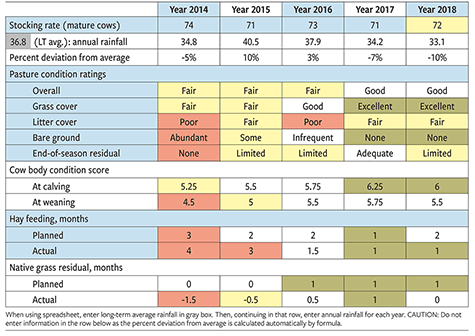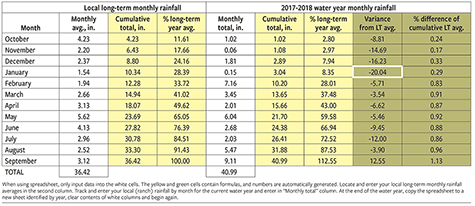Stocking Rate Tips
Noble Research Institute consultant offers tips on preparing for drought.
The issue with unintentional stocking rates is that producers set a number but don’t manage that number. They set the number based on history and experience, instead of a science-based approach, says Hugh Aljoe, a pasture and ranch consultant and director of producer relations with Noble Research Institute.
They may measure rain, but they don’t use it to set their stocking rate. Grass is a renewable resource, but only if there’s rain and active management.
| Table 1: Intuitive ranch assessment |
 |
| Click here for larger image. |
However, an intentional cattleman sets and adapts their stocking rate according to rainfall and inputs. Aljoe outlines a tool he’s developed that could be replicated — an intuitive ranch assessment (see Table 1). It includes key categories, like rainfall, pasture status, body conditions and feeding rituals, and then rates them whether they have improved highly or moderately, or declined highly or moderately. There is no middle-option default, so you have to decide whether you’re improving or not.
This helps adjust your stocking rate objectively. Aljoe shares that often cattlemen end up feeding hay for much longer than they anticipated, and that means they are overstocked.
“For every month you’re forcing cattle to ‘hustle’ or are feeding hay over what is planned for during the winter, you’re at least 8.3% overstocked, because 1⁄12 is 8.3%,” he says.
There is a way to predict a drought and the appropriate stocking rate with a regional water year table (see Table 2). His begins in October because that’s when the recharge begins within his soil profile in Oklahoma.
| Table 2: Water year rainfall table |
 |
| Click here for larger image. |
“Spring begins in about April for most of us. We take our long-term average and monthly average; add those up. Then we put [it] into a cumulative total, and then put it on a percent basis. Do the same as we go through the year and track along together. We can determine if there’s a variance between the two.
“If it’s positive, we have more grass, typically, than we should. If it’s negative, we’re running behind,” he continues. “If you look at the percentage difference between Q1/Q2 and the long-term average, it’s the actual-to-date vs. the long-term expectation at the same date.
“So, we’ve got all this information right here. The producers that I worked with that were using this during the drought of 2011, they saw it coming,” Aljoe recalls. “They destocked in early May. April shows -19%, so they destocked by 20%. They made it through the rest of the summer just fine under drought conditions because they had the early-warning system right there.”
For more information on consulting services by Noble Research Institute, visit www.noble.org/ag/.
Editor’s note: This is taken from a full article in the April Angus Beef Bulletin about pasture management and stocking rate. You can see the whole article at http://www.angusbeefbulletin.com/ArticlePDF/0419-Dynamic-Systems.pdf.























